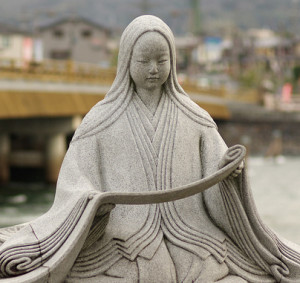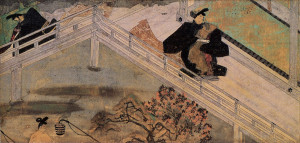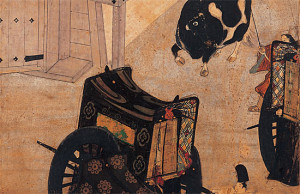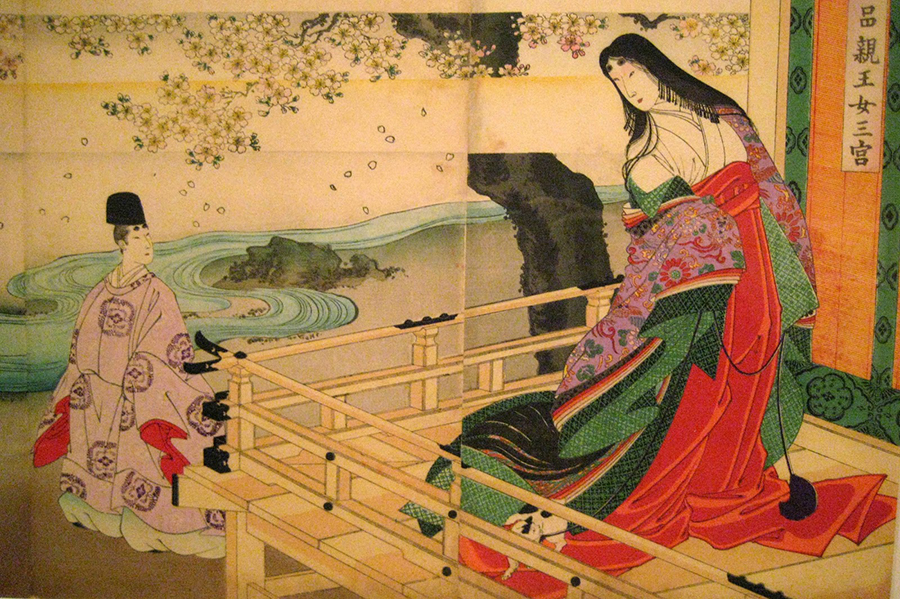by Bailey Dolenc

Murasaki Shikibu was one of the world’s finest early novelists who inspired artists to paint the lifestyles of the Japanese aristocracy. Some argue that Murasaki wrote the world’s first modern novel. One could even say that she ignited the creation of our modern series of soap operas.
In her early twenties, Lady Murasaki married a distant relative. Her husband tragically died two years following the birth of their child. After hearing of her unfortunate circumstances and learning of her brilliant mind and exceptional writing skills, the Imperial family brought Lady Murasaki to court. During her time in Empress Shoshi’s court, Lady Murasaki kept a diary for two years. While giving a vivid account of court life in Japan’s literary pinnacle Heian period, it also gives insights into Lady Murasaki’s personal thoughts. In part, she did not agree with the frivolous aspects of court life. From the Imperial Palace in twelfth century Japan emerged her psychological novel, The Tale of Genji (Genji-monogatari).
 Lady Murasaki wrote The Tale of Genji in chapter installments which were later recorded on a scroll and illustrated delicately. The main character Genji, his love affairs, and those of his offspring are the main focus of the storyline. Interestingly, the illustrations in each chapter were created by different groups of skilled painters and monks. Psychological intensity is present in each painting with the painters’ elevated techniques of adding vertical and diagonal lines that coincide to portray heightened emotions and an underlying framework.
Lady Murasaki wrote The Tale of Genji in chapter installments which were later recorded on a scroll and illustrated delicately. The main character Genji, his love affairs, and those of his offspring are the main focus of the storyline. Interestingly, the illustrations in each chapter were created by different groups of skilled painters and monks. Psychological intensity is present in each painting with the painters’ elevated techniques of adding vertical and diagonal lines that coincide to portray heightened emotions and an underlying framework.  Aristocrats found interest in the artistic psychological presence, delicately painted brush strokes, gold and silver flakes, and precise calligraphy that some of the aristocrats created themselves. Other characteristics portrayed in the scroll which are associated with the Japanese aristocracy of this time include elaborate silk robes, soft and sympathetic faces, and lifted roofs to reveal the inner-workings of an aristocratic home as it was in twelfth century Japan.
Aristocrats found interest in the artistic psychological presence, delicately painted brush strokes, gold and silver flakes, and precise calligraphy that some of the aristocrats created themselves. Other characteristics portrayed in the scroll which are associated with the Japanese aristocracy of this time include elaborate silk robes, soft and sympathetic faces, and lifted roofs to reveal the inner-workings of an aristocratic home as it was in twelfth century Japan.
Similar to today’s soap operas, The Tale of Genji allows us to glimpse into the private world of romantic relationships. However, the art form has miraculously evolved from written and illustrated scrolls into film comprising a cast and crew. Now easily accessible, enthusiasts can watch their favorite soap operas via television, online, DVD, and DVR.
The scroll of the Tale of Genji is now preserved at the Tokigawa Art Museum and the Gotoh museum.
